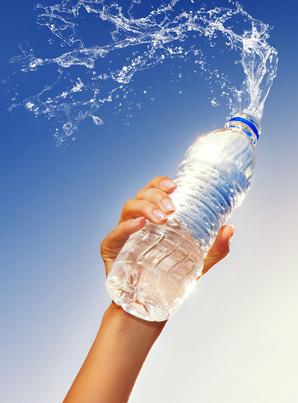A stroll down the beverage aisle of your local grocery store will show you many types of bottled water. There are types ranging from large jugs with spouts to small bottles that can be fitted inside a lunch box. We often are unaware of the processing that goes into getting that water from its original source.

Bottled water is normally bottled at the source and closed into containers for safe drinking. There are a variety of water types and water bottles to hold them. Let’s take a look at what types of bottled water are out there and how the water is filtered.
Artesian Water
This type of water comes from an aquifer that is being tapped. The level of the water is at a height above the topmost level of the aquifer. This type of water is very pure because the layers of rock that trap it also prevent contaminants from finding their way into the water. In spite of this, there is no guarantee that this type of water is any purer than ground water.
Purified Drinking Water
This water has been processed to remove most dissolved solids and chlorine. The distributor is not required to reveal the water source unless it is an untreated public source.
Water Safety Monitoring
Some people think that bottled water is no safer than tap water. Municipal water systems supply tap water that is monitored by the Environmental Protection Agency. The FDA is responsible for monitoring bottled water. Bottled water is actually one of the things most carefully monitored by the agency.
Each agency has slightly different testing standards. The EPS, for example, checks for asbestos, but the FDA does not. Water bottle companies are not compelled to disinfect or check for the presence of parasites. The reason the FDA has given is that the water source is unlikely to contain parasites. Stricter standards are in place to monitor for the presence of chlorine and lead.
The FDA is not the only organization tasked with ensuring the safety of bottled water. It is monitored also by each state and organizations like the International Water Bottlers Association (IWBA).
The Filtration Process
The bottled water filtration process starts at the water source. There are multiple water sources: municipal supplies, wells, and protected underground springs. The next part of the process involves filters that purify the water through various barrier sources, including source monitoring, ultraviolet light, ozonization, distillation, reverse osmosis, and source protections. Any one of these techniques, or more, can be used by bottled water manufacturers.
Different types of organic compounds can impart a funny taste to water. The goal of filtration is to remove contaminants like these. Filtration processes include membrane filters — these filters are good at removing organic impurities, and metal ions. Organic constituents can also be broken down using ozonization, while also sanitizing.
Overall Safety
Overall, the safety record for bottled water is quite good. Consumers can feel confident in the safety of the vast majority of bottled water available.
This article is provided by Fil-Trek – Industrial Filters. We are North America’s leading industrial filtration solution company. For more information about our filtration products visit, http://www.fil-trek.com/bag-filters.html
Overview Of Commerical Bottled Water Filtration

